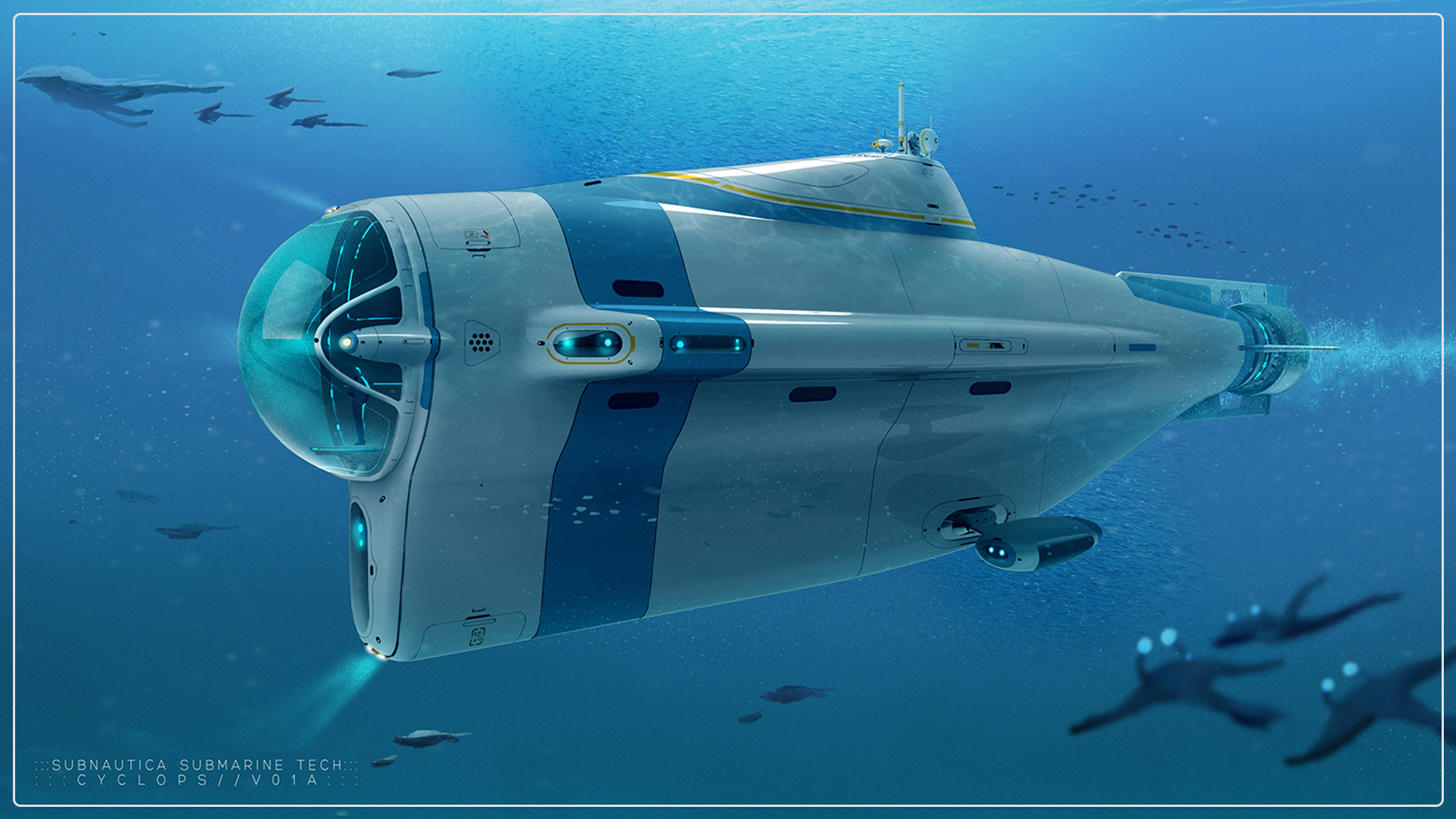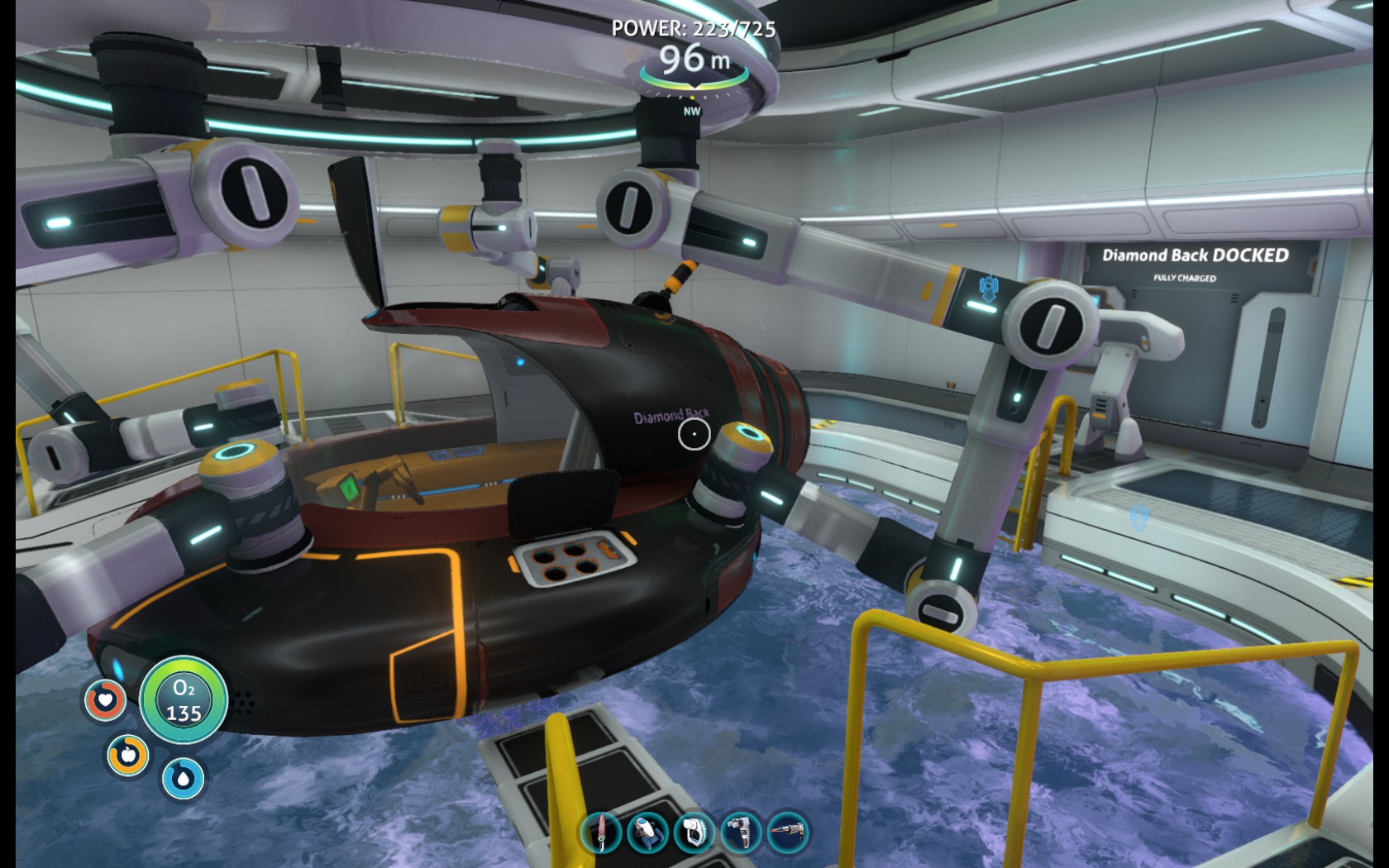It had been hours since I had seen sunlight. At this depth, the only real light sources were the ones made by the technology keeping me alive and the litany of bizarre life forms around me. As I moved forward through the darkness the seabed became flatter and soon almost barren of rock. I’d be going deeper and now I could hear bestial roaring in the blackness ahead. A sudden flash of blue, then another and soon the twisted metal hulk loomed into view: the sunken wreck I had been looking for. The Reapers were close, one for certain and maybe a second. I decided to jam my small submersible under an arc of rock and swim across to the wreck, I was sure Reapers didn’t attack unmanned craft but at this depth I didn’t want to take that chance. After cutting my way through the outer door my reward was quickly acquired, a blueprint for a new diving suit.
Suddenly a deafening crash and I could see my Seamoths tracking icon moving. For a second I forget this sub is my only source of oxygen at six hundred feet down and lament the time I had spent getting the paint scheme just right. With twenty or so seconds of Oxygen left I peer out of my prospective tomb observing that my Seamoth had stopped moving and was way out past the drop off hanging above a seemingly bottomless abyss. Assuming it was still operational I fired up my sea-glider and made a dart for it. A piercing roar, sickeningly close behind me: I’d been spotted and the apex predator was now behind me. Just at my last breath of air, I could see the damaged Seamoth and as my eyes started to go dark my hand touched the hull, I had made it. Pity that my death would come the second later as the terrifying maw of a Reaper came at me from the dark with unnatural speed. At ten percent structural integrity his would at least be quick. Then I saw it, a new device I had fitted on the Seamoth: a perimeter defence system which sends out a shockwave to would-be attackers. I stabbed the button and closed my eyes, the gargantuan creature reeled in pain giving me my chance. In the next second, I was ascending faster than greased lightning and hit the surface at such velocity that I was airborne for a good few seconds. Once satisfied that the danger was over I repaired the Seamoth and then watched as the sun came creeping over the horizon. For a second I forgot about the demonic monster below my feet and just enjoyed the moment, the sunlight really was beautiful.
Sink or Swim
The idea for Subnautica is a simple one, a large science ship known as the Aurora has crashed due to being hit by an unknown energy pulse, is now partly submerged and suffering from major structural damage. On the descent from orbit, you are knocked unconscious, coming around in your life pod alone and unsure what to do next. The only working device on the pod is a fabricator, which fortunately is able to break down matter and reform it into complex items. The crafting system in Subnautica is both easy to learn and robust enough to handle the many items you will need to craft. I like that the crafting tree makes sense: glass, for example, needs Quartz and electrical equipment requires silver or copper. You will notice quickly that every item you make drains juice from the pod's power reserves, luckily the pod comes with a set of three solar panels which will recharge in the daytime. However, you cant hide in your pod forever and at some point, you will need to eat.
When starting Subnautica you will have a few choices about the type of game you wish to play: for the purpose of this review please assume I am playing the survival mode (I highly recommend this as your first playthrough). You have a health bar and a nutrition/hydration gauge which go down fairly rapidly - so you must catch the smaller fish and cook them in the fabricator. Initially, you can make bleach from salt and coral to make drinkable water but this is just a temporary solution.
As you dive into the watery world for the first time you will notice that the pod and the crippled Aurora are the only objects on the horizon, everything else is an endless ocean as far as the eye can see. Under the waves, your eyes are met with a scene that at a glance could be Australia or any other tropical coral reef. Fish dart through the light beams cascading down from the surface, the uneven ocean floor is home to weeds, rocks, coral and a multitude of other plants and objects. There is an incredible amount of variation in the topography of the seabed, from intricate cave systems, escarpments blazing with colour and volcanic fissures spewing steam and rock into the sea. You may also start to notice not all the creatures in the depths are on a vegetarian diet. The seabed is split into many biomes which vary massively in aesthetics and also the kind of fauna you will encounter. After building a basic set of flippers, an aqualung and survival knife you will need to move away from your pod and start your journey.
Safety in Titanium
Once you have developed the builder tool this then, in turn, allows you to construct pressurised structures on the seabed with an assortment of options. The buildings themselves are very easy to place and the whole system is modular. As soon as you build a solar panel (within range of a structure) this will pump energy into the storage cells and get power flowing into any devices you have inside such as fabricators and water filtration systems. When at shallow depths where sunlight easily penetrates the ocean, solar panels are the best choice but as you get deeper they become less effective until finally, you will need to find other ways to power your installations. In addition, as the sun goes down the panels will stop working until the next morning and it's these robust systems that really stand out. For example, every structure you build comes with an integrity value which can be affected by various actions. Just by adding more tunnels and rooms you will lower the structural integrity, which will eventually lead to breaches and a flooded base. You can add reinforcements, bulkheads and use foundations which all add integrity. Obviously the deeper you get the less each structure will be able to take and adding that window for a view of the Mushroom Forest could leave you with soggy feet.
Another aspect of construction you will come across are the vehicles of Subnautica which all have a role to play. The Seamoth, a small one-man submersible, is your general runaround that is both fast and versatile. Once you have the resources to can also build the Cyclops, a massive vessel that acts as a mobile base. What I found to be a testament to how solid this games engine is, is that you can actually build structures inside your Cyclopes in any position you wish. It is standard for me to have crops growing and an aquarium of tasty fish for those long missions. My favourite vehicle by far is the Prawn Suit, which is designed for deep exploration and drilling operations. It is this vehicle that you will rely on to see the deepest places of the ocean where your nightmares lie in wait.
One element of Subnautica that I have found to be very enjoyable is how clever the equipment is and the seamless way it works within the various environments. Flares, air-pipes, beacons and even small gravity wells offer fun ways to tackle various situations. Developing a thermal knife will allow you to cook fish in the field and you can even use flippers that will charge your other gadgets as you move. Once you have a modification station and a working Moon Pool you can start to create mods for your gear and vehicles. Adding solar panels to your Seamoth, for example, can make long exploration trips less stressful. Similarly, you can give the Prawn Suit the ability to charge up from volcanic vents on the ocean floor or hold extra storage. As mentioned, your Prawn can drill large deposits of resources and also be fitted with a grappling hook. Whoever doesn’t see the instant advantage of a grappling hook isn’t worth their salt in my opinion and in one confrontation I used said equipment to drill a very large predator in the face. Needless to say this led to me having a hallway of my base with pictures of my Prawn atop each large kill I made with my drill and grappling hook combination. Move over Moby Dick.
Due to the blueprint database being corrupted in the crash, many of the items you will need to build are not immediately available. However, pieces of the Aurora are scattered across the ocean floor at various depths, which leads to something of a treasure hunt. Searching for sunken wrecks has been one of the standout parts of the game for me. I remember in one instance finding a wreck on the edge of a drop-off, at around two hundred and fifty feet down. Unfortunately, at that time my Seamoth could only get to two hundred feet before being crushed under pressure. So this resulted in me diving down to the wreck, cutting through various metal doors and then swimming back up to my sub before drowning, which nearly happened a few times when getting lost within the watery corridors and rooms of what was once part of the main ship.
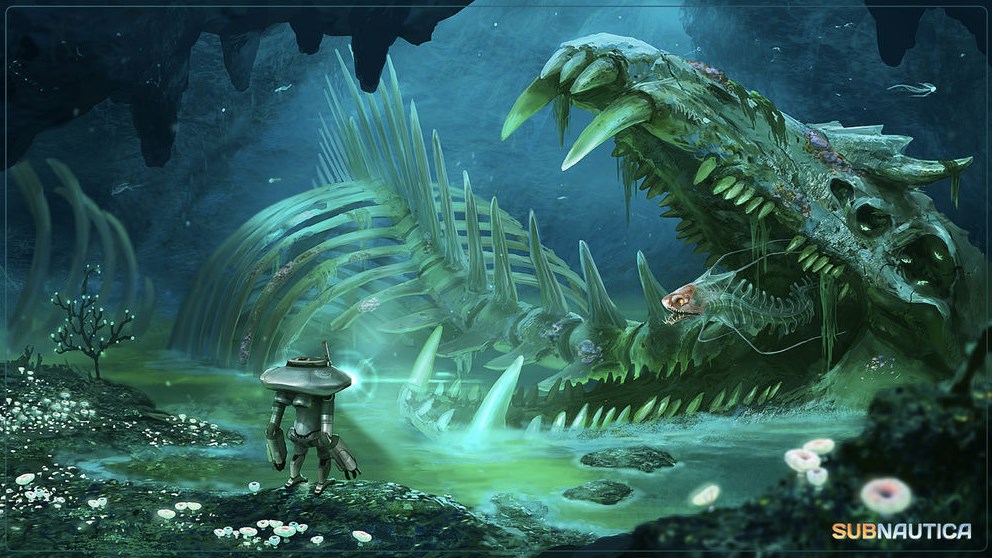

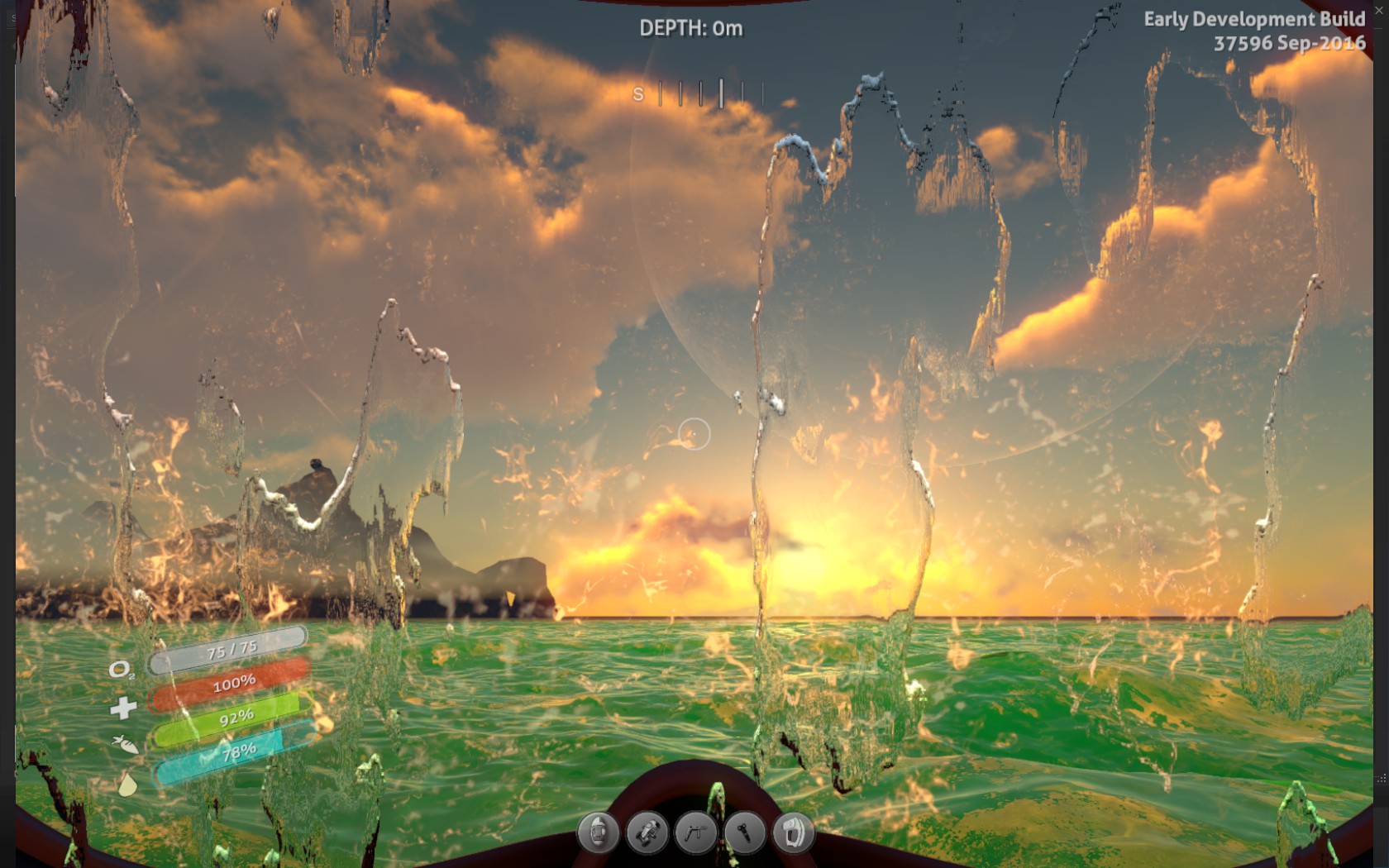
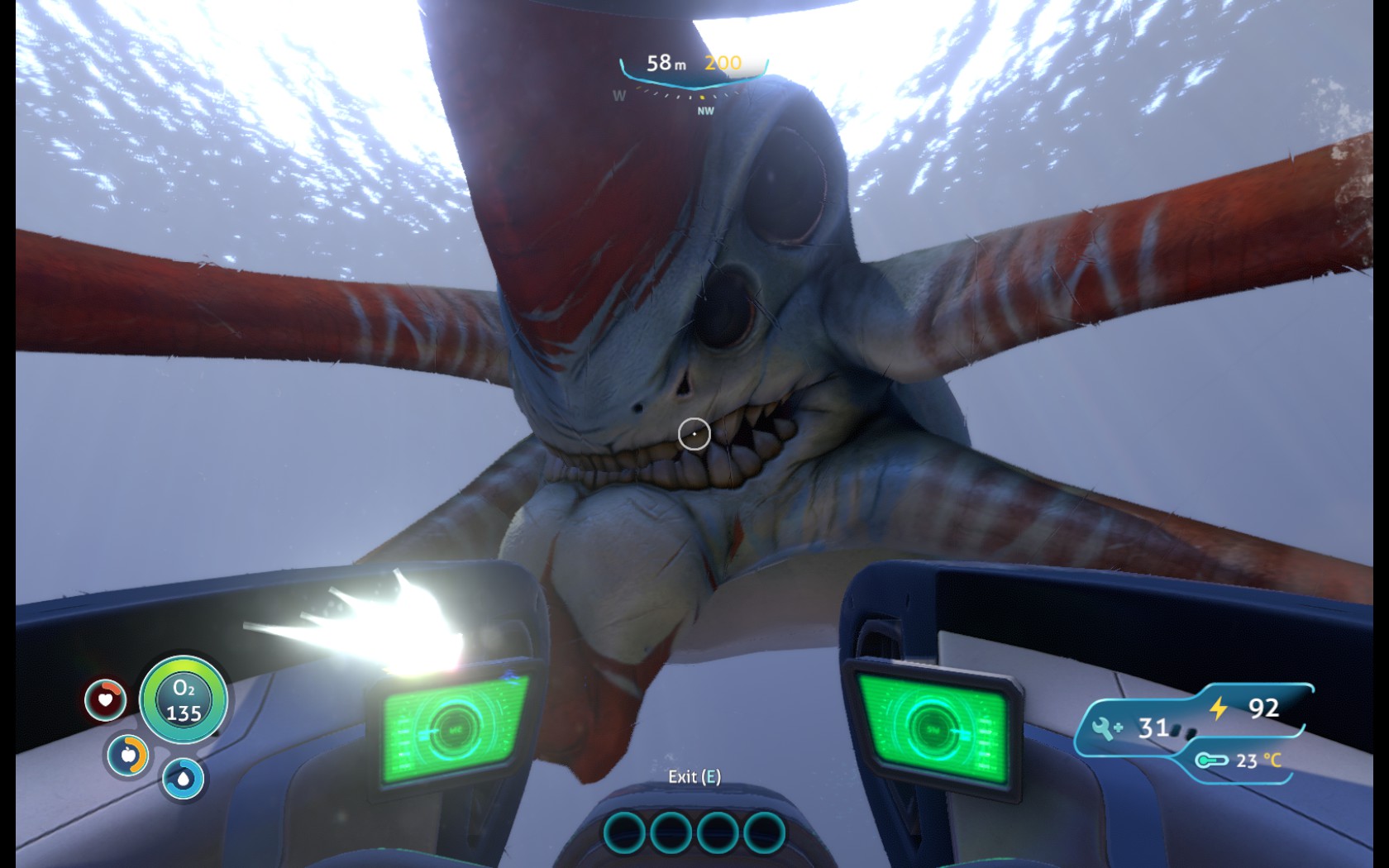

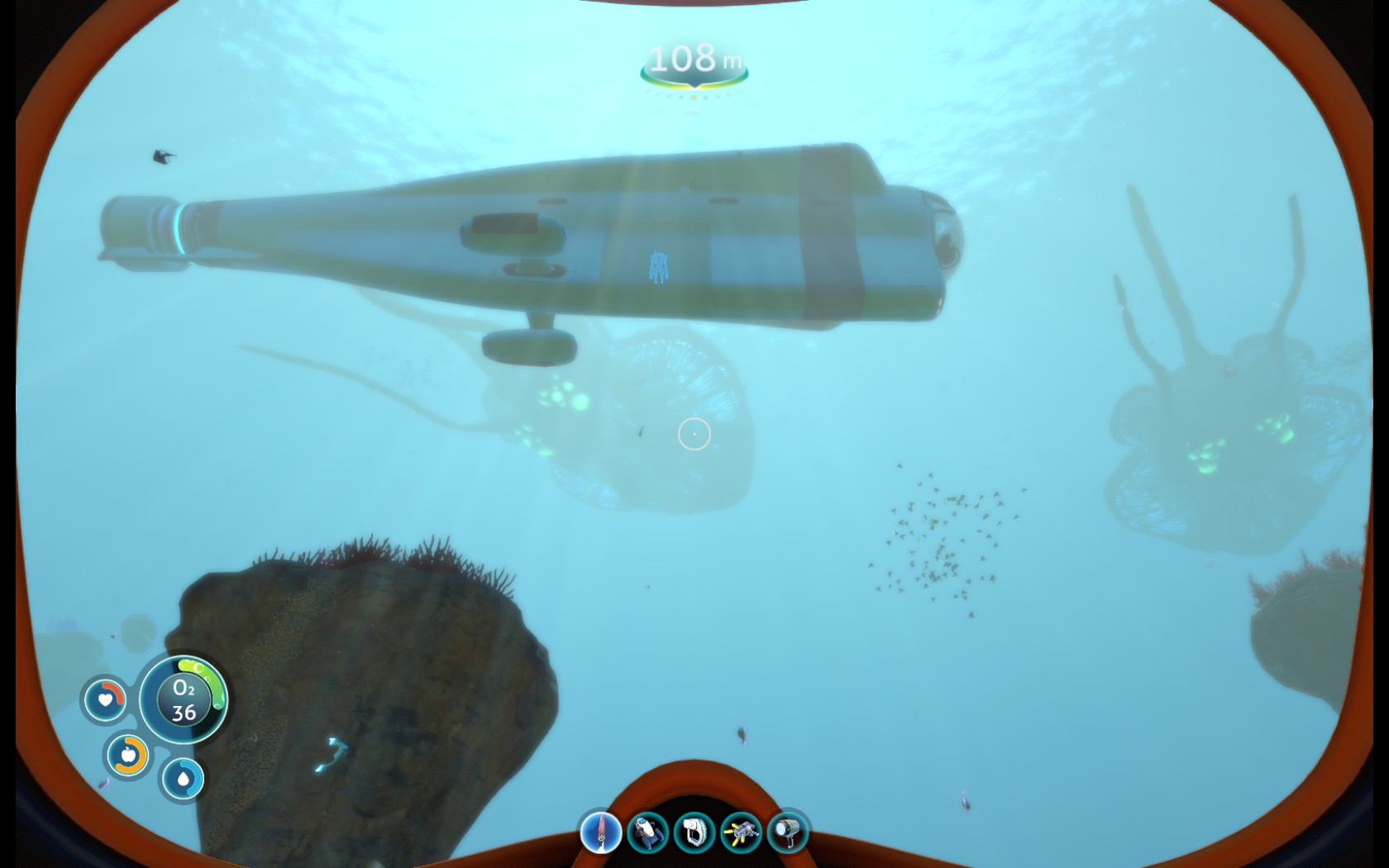
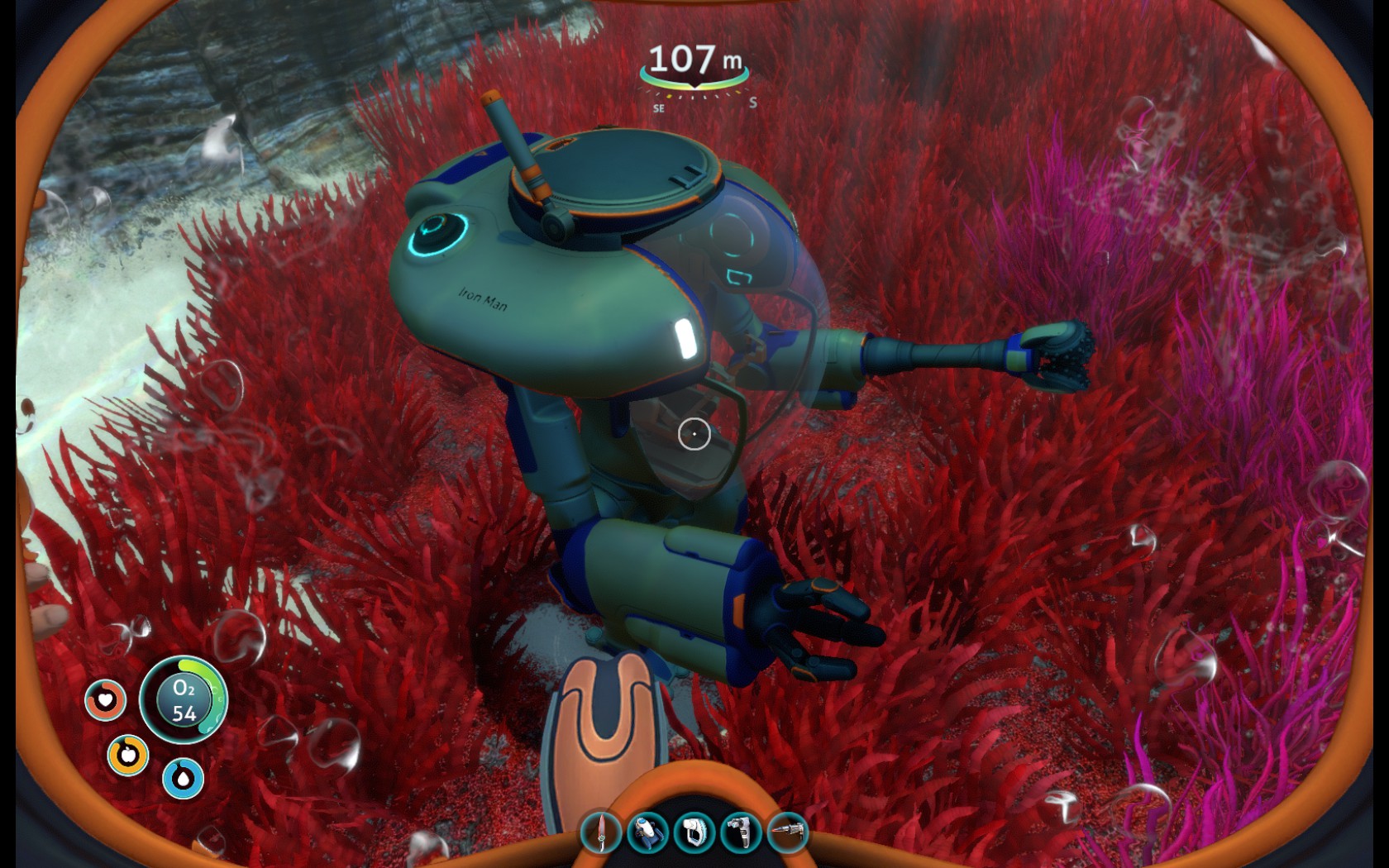
Interactive iteration
The first time I played Subnautica was shortly after it appeared on early access in 2014 and its potential was obvious. While the overall layout of the game has stayed solid much of the content and systems have seen big changes. I remember at one point you could actually deform the rock and build new shapes. This was fun but ultimately it didn’t fit with the developers’ overall vision. I would like to make a special mention of the developers, Unknown Worlds Entertainment, who have made Subnautica a reality; the way they have included their fans in the creative process has been inspirational. All the way through the iterative process their goals and decisions have been made very clear. From a very early point, it was decided that lethal weapons would not be a thing in Subnautica because the team wanted to promote a more creative experience and I applaud this approach. I also remember there being a definite choice for the studio to either try and include cooperative play or focus more on the single-player experience. While at times I have thought it would be nice to explore with someone else, the decision to stay solo was bang on. Maybe Chris Roberts could take note here: you shouldn’t try and cram every good idea into your game, lest it becomes bloated and ultimately never sees the light of day.
Wish you were here
As you regain consciousness in your escape pod you are introduced to your PDA, which boots into emergency mode and is designed to keep you alive. The voice of the AI, while not human, does break through the solitude and provide a feeling that at least something on this planet is in your corner. Your PDA houses all the information you could ever want from survival tips to blueprints and a summary of everything you scan. I found it really fun to collect information on the creatures around me and in a role-playing element saw it as my scientific duty. Soon after the crash, your radio receiver starts to pick up distress messages from other members of the Aurora crew, usually in mortal peril of some kind.
Here’s the thing, these recordings actually give you not only coordinates to check but start to build a bigger picture of what is happening around you. When you visit these locations there is often a sombre story that confirms in pictures how events continued after the voice recording finished. These voice recordings are of a very high quality and a real surprise as the story elements were never really seen in the early access phase of the game.
Is it PC?
There has been one glaringly obvious problem with the visuals in Subnautica from the very first day and that is the terrible pop in. Some biomes get away with this but most just seem to appear out of thin air. In the very early builds, I assumed these pop in problems would be addressed as the game got optimised but even in the 1.0 version the problem persists. I am not an engine jockey or coder so do not have the chops to theorise on why this is so obvious in Subnautica. I only know that as a gamer I wish it did not happen because the pop in can really diminish the wonderful suspension of disbelief the rest of the visuals can accomplish. Aside from this issue the game runs at a very respectable frame rate and only suffers occasional dips, usually when entering a vehicle or surfacing. The game is actually built on the Unity engine, simply because the team were far more familiar with this software. One element to the game I have not tried yet is playing in VR, which is now supported in the base game. The pop in issues aside, this game is breathtakingly beautiful and exudes atmosphere. Having spoken to a friend who has tried Subnautica in VR, he says the experience can be magical but the controls leave a lot to be desired. I would hope the team continue to work out the bugs, I will be getting VR later this year so expect an update then.
As far as I’m concerned the sound work in this game is some of the best in the industry. Not only is it of a high standard in terms of quality but also directional cues. Even when in total darkness I can glean a great deal of information and the type of threats around me just by listening. Your equipment also gives you plenty of good audio feedback which is essential for those quick decisions. The music was also a surprise as when you are in certain situations or enter a new biome a fast-paced synthwave track will pound in your ears: almost like how you hear your own heartbeat when panicking.
Summary
In the last four years I have played with the various builds of Subnautica for many hundreds of hours and now we have it in its final state the obvious question is, was it worth the wait? One hundred and ten percent yes. This game and its talented developers have shown exactly how you make an early access game. Not just for what they have put into the final experience but also what they had the sense to leave on the drawing board.
I have experienced a broad range of emotions while playing Subnautica, from loneliness, fear, exhilaration and many more. It is the case that I have a genuine fear of the ocean and more specifically deep water. When in the darkness hundreds of feet below the surface I have been terrified, sometimes by what I could see but more often from what I couldn’t. The fact this game has been able to affect me in such a real way is a testament to how well made it is. The team at Unknown Worlds Entertainment have created a stunning world here and its hard not to sit back in awe, whether that be the sunset over the horizon or the fading sunlight giving way to darkness in the kelp forests. If you enjoy survival games then this is an absolute must own title and for everyone else, I would urge you to take a look.
Thank you for reading my review of Subnautica, I hope you enjoyed reading it as much as I enjoying writing it. If you love PC gaming and wish to support me in what I do please share my work on social media and follow me on Twitter @riggedforeic


